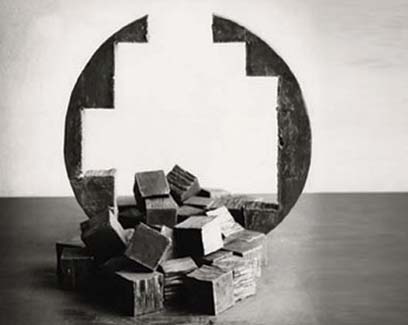Giuseppe Spagnulo
dal 17/9/2003 al 1/11/2003
Segnalato da
17/9/2003
Giuseppe Spagnulo
Barbara Behan Contemporary Art, London
A lot of work present the career of one of the most significant Italian artist. Sculptures and paintings including the series Ferri Spezzati and La Rosa Dei Venti

Barbara Behan is pleased to present the first major solo exhibition by Giuseppe Spagnulo in London. This important exhibition by one of Italy's most significant living artists is a rare opportunity to view work spanning his Ferri Spezzati (Broken Iron) series of the early nineties to the pres-ent day. The exhibition explores the artist's unwavering conviction that sculpture's primary purpose is to question and criticize social norms, often to the point of destruction. Rejecting the idea of an unremitting progression towards a utopian society, Spagnulo's work references the space of other perspectives, the object of relativity and an environment in which to communicate. His definition of space is one detached from every descriptive and referential constraint: 'I don't believe that one form could be more perfect than another but I do believe in the quantity of space that a form puts in motion'.
All the sculptures featured in this exhibition are made of iron or steel. The metal is rendered supple and malleable by its passage through fire and retains the marks of the blows that shape it. This forging and twisting of the steel give his forms an erotic dimension, which interrogates and invades the space that they occupy in an attempt to break some of the symbols of social harmony.
Amongst the works exhibited, Ferro Spezzato or Broken Iron symbolizes the breaking of geometrical balances (circles) and the forcing of the cut, an act that challenges the craftsmanship of the piece. Or, put another way, a minimum act that exerts maximum power. It is disarmingly simple work, that he himself regards as almost proletarian, but is a clear example of why, to paraphrase his own words, he doesn't care about form but rather the concept of form.
Another work that illustrates the fundamental role of the cuts is La Rosa Dei Venti. The cuts that Spagnulo applies to the iron emphasise the molecular energy of the material, its centripetal or centrifugal dynamism. This energy is the principle feature of his work. 'My work is complete when it is light as a leaf even if in reality it is very heavy'. Although firmly rooted to the ground, the lightness of the piece gives the impression of flight.
Spagnulo's paintings embrace a three dimensional form that hugs the wall. Corpo di Fuoco, for example, consists of layer upon layer of paper, volcanic sand and charcoal framed by the heavy iron that is the hallmark of his sculpture. The work explores the idea that in order to build something new it is necessary to destroy what was there before. The layers symbolize the pages of a book to be read and questioned in detail as if they were some ancient text signing the history of mankind.
Giuseppe Spagnulo was born in 1936 in Grottaglie (Taranto in Puglia), one of Italy's historical centres of ceramic art. He spent the 1950s at the Istituto della Ceramica in Faenza, an international mecca for artists working in clay. His time spent at the Academia di Brera in Milan aroused his interest in Spatialism, the Nuclear movement and other 'high temperature' materials such as iron.
In the 1960's he worked as an assistant to Lucio Fontana and Arnaldo Pomodoro and was in close contact with Piero Manzoni. In 1968 he joined the protest demonstrations and collaborated with factory workers of the iron plants and workshops to conceive the first of his 'grandi ferri' or 'big metal' sculptures thus commencing his ongoing dialogue with the urban space and the public. The work he produced in iron from 1968 to 1972 - Black Panther (1969), La grande trappola (1971), Ascesa diagonale (1971) and Tubi in diagonale (1972) - were among the most groundbreaking Italian sculptures of the period. Spagnulo's art grew increasingly conceptual due to the influence of "anarchic" art forms of the 1960s, such as happenings, performances and the activities of the Fluxus movement. His own demand for spectator participation resulted in two major horizontal sculptures for the Newport Harbor Art Museum, California, whose floor-level development recalled the experiences of American minimalism.
In the early nineties, following his huge success in German galleries and museums, Spagnulo was appointed professor of sculpture at the Stuttgart Academy of Fine Arts, a post he has retained until today.
His most recent critical tributes are the award of the 'Premio Faenza alla carriera' showcasing his work in clay from the seventies to the present at the Museo della Ceramica as well as the prize of the International Contest of Street Furniture: a sculpture, Scogliere, made of five enormous steel blocks installed before the Taetro degli Arcimboldi in Milan.
Barbara Behan Contemporary Art
50 Moreton Street
London SW1V 2PB
Tel/Fax + 44 (0) 20 7821 8793



